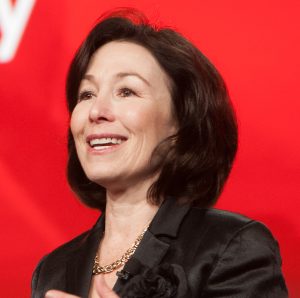- The Year of Real Power: Leadership Lessons from 2024
- Expert Corner: Insights from Industry Leaders on Turning Challenges into Opportunities
- Executive Movements: Transitions and Pivots
- Career Development Advice: From Insulation to Innovation – The Disruption Opportunity
View From The Top

Rajesh Khanna,
President,
Vantedge Search
From insights into the strategies of leaders like Jensen Huang and Lisa Su to actionable advice on thriving amid change, this edition equips leaders with the tools to innovate, inspire, and drive meaningful impact in the year ahead.
As you set the course for your organization’s success in 2025, I encourage you to draw from the stories and strategies shared here. On behalf of the entire team at Vantedge Search, I wish you a prosperous, resilient, and innovative New Year. Let’s embrace the future together!
The Year of Real Power–Leadership Lessons from 2024

In 1929, Henry Luce launched Fortune with a vision: to chronicle power in business and highlight the leaders shaping industries and society. Nearly a century later, Fortune’s inaugural list of the 100 Most Powerful People in Business offers a timely reflection on what it means to lead in a world marked by constant change. These are leaders whose influence reshaped industries, whose vision challenged conventions, and whose decisions set the pace for others to follow.
But what does “real power” look like today? It is no longer confined to revenue or titles. As Fortune suggests, power in 2024 is nuanced, dynamic, and deeply tied to how leaders navigate complexity. From redefining industries to fostering cultural shifts within their organizations, the leaders at the top have demonstrated that true influence comes not just from holding authority, but from wielding it with purpose, agility, and foresight.
As we close the year, their stories provide a wealth of lessons for leaders everywhere. What did these individuals do differently? How did they not just survive but thrive in an era of disruption, uncertainty, and transformation? Here are six key takeaways from the year’s most impactful leaders.
1. They Focused on the Long Game While Excelling in the Present
Leaders like Satya Nadella and Mary Barra are proof that balancing short-term demands with long-term vision is essential. Nadella steered Microsoft to record-breaking growth while positioning the company as a frontrunner in AI, ensuring its relevance for decades to come. Similarly, Barra didn’t just double down on electric vehicles—she laid the groundwork for GM’s transition to a sustainable future, all while maintaining operational excellence.
Lesson: Effective leadership is about duality—meeting today’s challenges without losing sight of tomorrow’s opportunities.
2. They Thrived on Disruption, Not Despite It
The past year was rife with upheavals, from the rapid integration of generative AI to shifting geopolitical landscapes. Leaders like Jensen Huang of NVIDIA leaned into this disruption, capitalizing on the explosion of AI to dominate the chip industry and shape the technology driving innovation worldwide.
Lesson: Disruption isn’t a threat; it’s a launchpad. Leaders who embrace change and adapt quickly are those who create new opportunities rather than reacting to challenges.
3. They Elevated Purpose Over Profit
Purpose-driven leadership became more than a buzzword in 2024—it became a strategic imperative. Leaders like Mellody Hobson exemplified this by fostering inclusivity and using influence to promote systemic change, proving that aligning business goals with societal values is not just ethical, but it is a competitive advantage.
Lesson: Modern leaders recognize that trust and loyalty come not from what you sell, but from what you stand for.
4. They Built Resilience Through People
The labor market has undergone profound changes, with hybrid work and automation reshaping the future of work. The most successful leaders prioritized their people, fostering cultures of learning, inclusion, and collaboration. They didn’t just focus on technology but invested in their workforce as the ultimate driver of resilience and innovation.
Lesson: Leadership is human at its core. Empowered, engaged employees are a company’s best defense against uncertainty.
5. They Redefined Power Through Influence, Not Authority
Power in 2024 was not about titles or even revenue—it was about influence. Leaders like Sam Altman went beyond just creating groundbreaking technology; they shaped how industries, governments, and consumers approached AI. Their power came from their ability to set agendas and inspire action across sectors.
Lesson: Influence is earned, not given. Real power comes from shaping the narrative, inspiring belief, and driving collective action.

6. They Turned Vision into Reality
Vision without execution is just a dream. The most powerful leaders of 2024 did not stop at imagining bold futures—they brought them to life. Whether by driving innovation, launching transformative products, or leading with empathy, these leaders bridged the gap between aspiration and impact.
Lesson: Great leaders move from “why” to “how.” They translate ambition into actionable strategies that deliver real-world results.
Looking Ahead to 2025
As we step into 2025, these lessons resonate more than ever. Leadership has transcended from being solely about power to being more about using it to create lasting impact. The challenges ahead, from climate action to economic volatility, will demand leaders who are adaptable, courageous, and deeply committed to shaping a better future.
For more information on Vantedge Search, please contact us. We look forward to hearing from you.
Expert's Corner –
What's Trending?
Insights from Industry Leaders on Turning Challenges into Opportunities
Here, we spotlight three extraordinary executives who turned challenges into opportunities and exemplified what real power means in today’s dynamic business environment:

Jensen Huang, CEO of NVIDIA: The Relentless Visionary Redefining AI Hardware
Jensen Huang, CEO and founder of NVIDIA, is a towering figure in the AI revolution, earning the No. 2 spot on Fortune’s 2024 Most Powerful People list. Known for his relentless work ethic, Huang has transformed NVIDIA into the backbone of AI innovation, with its GPUs dominating the AI training market and powering global advances in generative AI and data centers. Under his leadership, NVIDIA’s market capitalization soared to $3.4 trillion, bolstered by a sevenfold stock price increase since the debut of ChatGPT in 2022. Huang’s unconventional management style—eschewing one-on-one meetings in favor of collaborative leadership—has helped NVIDIA maintain a flat, agile structure critical for its success. Despite geopolitical challenges and rising competition, Huang’s strategic foresight, including investments in software ecosystems like CUDA and cutting-edge chips, has solidified NVIDIA’s position as a global AI leader.
Lisa Su, CEO of AMD: The Strategic Challenger in AI Computing
Over her 10-year tenure as CEO of AMD, Lisa Su has transformed the company from a struggling chipmaker into a diversified powerhouse. Under her leadership, AMD expanded beyond PC microprocessors into gaming, high-performance computing, and now, AI-driven data centers. While Nvidia dominates the AI chip market, Su’s strategic moves, including the launch of the Instinct MI300 chip—which generated over $1 billion in Q2 2024—and the acquisition of Finnish AI company Silo, position AMD as a formidable challenger. With $22.7 billion in revenue last year and an expanding AI-focused product lineup, Su exemplifies the power of disciplined execution and forward-looking innovation.

Safra Catz, CEO of Oracle: Reinventing Collaboration in the Cloud Era
As CEO of Oracle since 2019, Safra Catz has strategically steered the 47-year-old tech pioneer into the modern cloud computing landscape. Recognizing the enduring value of Oracle’s market-leading database software, Catz forged groundbreaking partnerships with competitors like Microsoft Azure, Google Cloud, and AWS, allowing their customers to integrate Oracle’s offerings seamlessly. These alliances have reinvigorated investor confidence, with Oracle surpassing earnings expectations in September 2024, reporting $13.3 billion in revenue (up 7% year over year). Catz is equally bullish on AI, securing significant deals, including one with OpenAI to bolster its cloud infrastructure for training advanced AI models. Her leadership demonstrates the power of innovation through collaboration, positioning Oracle for sustained growth in the evolving tech ecosystem.
“Lessons for Leaders”
These leaders have not only navigated disruption but turned it into a force for growth and impact. As 2025 approaches, their insights stand as a guiding light for leaders looking to thrive in an uncertain world.
Executive Movements:
Leadership Transitions & Strategic Pivots
CEO Movements
Volkswagen Group of America has appointed Kjell Gruner, a former Rivian executive, as its new North America CEO effective Dec. 12. Gruner, with over 25 years of automotive experience, replaces Pablo Di Si, who stepped down after two years.
Peloton has named Peter Stern, a former Apple executive with expertise in subscription services, as its CEO effective Jan. 1, 2025. Stern’s experience managing Apple Fitness+ and other digital platforms positions him to guide Peloton’s turnaround following a post-pandemic sales slump.
Chipotle Mexican Grill has appointed Scott Boatwright as CEO and board member, effective immediately. Boatwright, formerly COO and interim CEO, has been pivotal in enhancing guest experience, integrating technology, and driving industry-leading retention rates.
Kohl’s has appointed Ashley Buchanan, CEO of Michaels Companies, as its new chief executive officer, effective Jan. 15, 2025. Buchanan, with extensive experience at Walmart and Michaels, succeeds Tom Kingsbury, who led Kohl’s during a challenging period of declining sales and market share.
Domino’s Pizza Enterprises has announced the retirement of CEO Don Meij after 37 years with the company, including 22 years as CEO. Mark van Dyck, former regional managing director at Compass Group, succeeded Meij as CEO and Managing Director from Nov. 6, 2024.
Hyundai Motor Company has appointed José Muñoz as its President and CEO, effective Jan. 1, 2025, succeeding Jaehoon Chang, who has been promoted to Vice Chair of Hyundai Motor Group.
Kering has appointed Cedric Charbit as CEO of Saint Laurent, effective Jan. 2, 2025. Charbit, previously CEO of Balenciaga and a former Saint Laurent executive, replaces Francesca Bellettini, who will focus on her role as Kering’s Deputy CEO. This leadership reshuffle, including Gianfranco Gianangeli stepping in as Balenciaga CEO, reflects Kering’s strategic efforts to boost growth across its luxury brands.
Nature Fresh Farms has appointed Patrick Criteser, former Tillamook CEO, as its Chief Executive Officer effective Dec. 2, 2024. With over 30 years of leadership experience, Criteser aims to lead the company’s rapid expansion in sustainable greenhouse-grown produce. Founder Peter Quiring will transition to Executive Chairman, as Nature Fresh Farms continues innovating in sustainable farming and delivering premium, nutritious fruits and vegetables to markets across North America.
Sprinklr has appointed Rory Read, former Vonage CEO, as its new president and chief executive. Read, 62, brings extensive leadership experience from roles at Vonage and Ericsson. Founder Ragy Thomas will remain chairman and advisor, as the company focuses on advancing its customer-experience-management platform under Read’s leadership.
CFO Movements
Numerous companies welcomed new CFOs in October 2024, highlighting strategic financial shifts across industries.
- X Corp: Mahmoud Reza Banki, former Tubi executive, joins as CFO to help reshape the social media platform’s operations under Elon Musk’s vision.
- Canva: Kelly Steckelberg, ex-Zoom CFO, brings her expertise to Canva as it strengthens its position against Adobe.
- Wiley: Bradley Bonneau, with over 20 years of finance experience, joins Wiley as CFO to lead strategic and operational finance.
- Flex: Kevin S. Krumm, with extensive industry experience, is appointed CFO to drive growth across Flex’s global operations.
- Autodesk: Janesh Moorjani, former CFO and COO of Elastic NV, becomes Autodesk’s CFO to enhance scalability and growth.
- Marti Technologies: Deniz Terlemez takes the role of interim CFO, leveraging experience from Reef Technology’s Middle East operations.
- Natural Grocers: Richard Hallé is appointed CFO, tasked with overseeing financial operations and strategic planning.
- Inspired Entertainment: James Richardson assumes the dual role of CFO and CAO, bringing expertise from Manchester Airports Group.
- Collective Metals: Devienne Mok joins as CFO to bolster financial management for the company’s North American exploration projects.
- The Giant Co.: Will Regan is named CFO, overseeing all finance functions and real estate strategies for the company.
CIO/CTO Movements
- Cencora appoints Pawan Verma as CDIO
Global pharmaceutical leader Cencora, Inc. has named Pawan Verma, a seasoned tech executive from MetLife, as its new Chief Digital and Information Officer to drive innovative healthcare solutions. - Ryan Smith returns to Intermountain Health as CDIO
Ryan Smith, a long-time leader in healthcare technology, rejoins nonprofit Intermountain Health to steer digital transformation and innovation. - Guy Peri becomes CIDO at McCormick
McCormick, a global spice and flavor giant, welcomes Guy Peri, formerly SVP and CIO at Procter & Gamble, as its new Chief Information and Digital Officer. - Grant Thornton names Michael Kempe as CIO
Professional services firm Grant Thornton LLP has appointed Michael Kempe, a former KPMG senior leader, as its Chief Information Officer to enhance its technology-driven offerings. - UT Health San Antonio selects Michael Schnabel as CIO
UT Health San Antonio promotes Michael Schnabel, its long-serving CISO, to Chief Information Officer, marking a decade of leadership in healthcare IT. - Trex Company appoints Anand Kangala as CIO
Trex Company, a leading manufacturer of composite decking, has named Anand Kangala, a digital strategy expert from Home Depot, as its new Chief Information Officer. - University of Alabama elevates Mike Shelton to CIO
The University of Alabama has appointed Mike Shelton, a 25-year IT veteran and current deputy CIO, as its Chief Information Officer. - Newfold Digital welcomes Tony Murphy as CIO
Web and commerce tech provider Newfold Digital hires Tony Murphy, formerly CIO at Desktop Metal, as Chief Information Officer to expand its global technology footprint.
Insights: Inferring the why
The recent CEO appointments across diverse sectors, from technology to agriculture, underscore a unified response to evolving market conditions and organizational challenges. These transitions reflect a deliberate alignment of leadership capabilities with emerging business imperatives, paving the way for growth, transformation, and resilience in an unpredictable global landscape.
Navigating Growth and Transformation
A notable trend in these appointments is the emphasis on growth-oriented and transformational leadership. Companies are increasingly selecting executives with a proven history of driving profitability and innovation. These leaders are tasked with reinvigorating their organizations, particularly in competitive or stagnant markets, signaling a clear focus on rejuvenating business trajectories.
Leveraging Industry Expertise and Global Perspectives
Leadership choices frequently highlight the importance of deep industry knowledge and operational expertise. The appointees’ prior experiences in managing large, complex operations position them to effectively tackle the nuanced challenges of their sectors. Additionally, the global perspective many of these leaders bring—from managing international markets to navigating diverse regulatory environments—underscores the value of cross-market expertise in a world that demands adaptability.
Embedding Sustainability and Innovation
In sectors such as agriculture and technology, sustainability and innovation emerge as central themes. Companies are prioritizing leaders who can balance environmental responsibility with cutting-edge solutions, reflecting a broader shift toward ethical, forward-thinking operations. This alignment demonstrates a commitment to sustainable growth that resonates with consumer and stakeholder expectations.
Adapting to Market Disruptions
Frequent leadership changes point to a collective recognition of the need for agility amid market disruptions. Whether stemming from technological advancements, shifts in consumer behavior, or broader economic uncertainties, organizations are choosing leaders capable of navigating volatility and turning challenges into opportunities for growth.
Evolution of Founder Roles
In many instances, founders and long-serving CEOs are transitioning to advisory or board roles. This shift often coincides with the appointment of external candidates with specialized expertise, reflecting a readiness to embrace new ideas while maintaining continuity. These transitions signify a maturing of organizational structures, as companies prepare for their next phase of growth.
Reinforcing Customer-Centric Strategies
The increasing prominence of customer experience and engagement in leadership criteria highlights the growing importance of aligning business strategies with consumer expectations. Leaders with a focus on digitization, subscription services, and retail innovation are being entrusted to drive deeper customer connections and ensure long-term loyalty.
Preparing for a Digital Future
Executives with a strong foundation in technology and digitization are being placed at the helm, particularly in industries undergoing significant digital transformations. This strategic choice reflects a recognition that integrating technology into core operations is no longer optional but essential for sustaining competitive advantage.
Ensuring Stability through Succession Planning
Structured and thoughtful succession planning has emerged as a key theme, ensuring seamless transitions while preparing for future challenges. These deliberate strategies not only maintain organizational stability but also position companies to capitalize on opportunities in a rapidly changing business environment.
Conclusion
These leadership movements reflect how organizations are responding to the demands of a complex, interconnected world. By aligning leadership with strategic priorities such as growth, sustainability, customer-centricity, and technological innovation, companies are building a foundation for resilience and long-term success. These transitions, carefully curated and thoughtfully executed, demonstrate a collective recognition that the right leadership can drive not only organizational transformation but also industry-wide evolution.
From Insulation to Innovation: The Disruption Opportunity
To turn disruption into a competitive advantage, leaders need a proactive approach. Insulating oneself from disruption isn’t about building walls; it’s about creating robust, adaptable systems. Here’s how to lead through disruption:
- Anticipate, Don’t React
Leaders must become adept at spotting weak signals of change. This involves investing in trend analysis, surrounding yourself with diverse thinkers, and developing scenario plans for multiple futures. The earlier you identify a potential disruption, the more time you have to turn it into an opportunity.
- Cultivate a Culture of Experimentation
Organizations that thrive in disruption are those willing to experiment, fail fast, and learn faster. Create environments where employees are encouraged to test new ideas and challenge the status quo without fear of reprisal.
- Balance Transformation with Continuity
Radical change can be destabilizing, but refusing to change is riskier. The key lies in balancing the transformative with the familiar: innovate in areas critical to future growth while ensuring your core operations remain resilient.
- Harness the Human Advantage
Technology may drive disruption, but people remain at the heart of every solution. The leaders of 2025 will be those who deeply understand and empower their workforce, fostering a culture of lifelong learning and adaptability.
- Leverage Networks and Ecosystems
No leader operates in isolation. Build strong partnerships and alliances to share risks, pool resources, and co-develop solutions. The ability to collaborate across industries will be a hallmark of leadership excellence.
- Stay Grounded in Purpose
Disruption often challenges an organization’s sense of identity. Leaders must ensure that every strategic pivot aligns with the company’s core purpose, maintaining trust and clarity in the face of change.
As 2024 closes, the question for the C-suite, therefore, is no longer whether disruption will come—it is how you will respond when it does.


